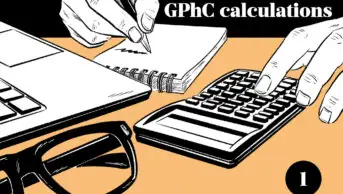
Mclean/Shutterstock.com
At the end of this article, individuals should be able to:
- Systematically work through concentration/dilution and health economics calculations to reach the correct answer;
- Ensure prescriptions requiring dilution of product are correct;
- Support medicines-related cost analysis activities;
- Understand the importance of units and rounding when solving calculations.
This article forms part of a series of pharmacy calculation video tutorials brought to you by The Pharmaceutical Journal. Click on the links below for more guidance on:
Calculating dilutions and performing cost analyses is a necessary skill for pharmacists. The ability to do so correctly is assessed by the General Pharmaceutical Council in line with the registration assessment framework.
In the following videos, Simon Harris, head of education at Greenlight Campus, provides trainees with a step-by-step walk through of how to solve three example calculations covering concentrations, dilutions and health economics. The following questions and answers are provided as examples only and are included to give you an idea of the types of question that will be asked during the registration assessment. Please note that these exact questions will not be included in the assessment.
Example 1: Paediatric concentrations and dilutions
Question:
It is late on a Saturday evening and a parent hands you a prescription. The out-of-hours GP has prescribed 150mL of paediatric pholcodine liquid for a girl aged 11 years, with the directions to give two 5mL spoonfuls three times per day. The paediatric version has been out of stock for three months and you only have the strong version of pholcodine linctus available. You discuss the issue with the parent and explain that you can prepare the paediatric linctus by diluting the strong version.
What volume of strong pholcodine linctus BP (10mg/5mL), in mL, will you need to add to a suitable diluent to prepare the full prescription of paediatric pholcodine linctus (2mg/5mL)?
Medicines and Healthcare products Regulatory Agency warning
Medicines and Healthcare products Regulatory Agency/Commission on Human Medicines advice on over-the-counter cough and cold medicines for children (issued in March 2008 and February 2009).
Over-the-counter cough and cold medicines can be considered for children aged 6–12 years after basic principles of best care have been tried, but treatment should be restricted to 5 days or less. Children should not be given more than one cough or cold preparation at a time because different brands may contain the same active ingredient; care should be taken to give the correct dose.
Solution:
Example 2: Concentrations and dilutions
You have been asked to prepare 250mL of carbamazepine oral suspension for an adult patient. Available in stock are all of the items required, except the carbamazepine 2% w/v, which you only have available as carbamazepine 3.75% w/v. The suspension is to be prepared according to the following formula:
- Carbamazepine (2% w/v) 10mL
- Citric acid monohydrate 2.5g
- Poloxamer 188 0.2g
- Potassium sorbate 0.3g
- Propylene glycol 2.1mL
- Purified water up to 20mL
What volume of carbamazepine 3.75% w/v, in mL, will you need to make the required suspension? Give your answer to one decimal place.
Solution:
Example 3: Health economics
Question:
A practice with a list size of 20,000 patients has agreed to support the clinical commissioning group initiative in switching some patients on quetiapine modified release tablets to quetiapine immediate release tablets. The average prices are shown below:
| Quetiapine modified release | £105/60 tablets |
| Quetiapine immediate release | £6/120 tablets |
Having completed a search, it is found that 1% of patients registered at the practice are prescribed quetiapine modified release tablets as a once-daily dose. The practice pharmacist reviews these and finds that only 10% of patients on quetiapine modified release tablets once daily are clinically stable enough to be switched to immediate release as a twice-daily dose.
What saving, in £s, can be achieved for a 30-day supply by completing the switch for the suitable patients?
Solution:
Additional calculations resources:
For thousands of practice questions to help you prepare for the GPhC registration assessment, including extended matching answer, single best answer and calculations, visit ONtrack.
RPS revision course with mock assessment
This course is designed for all foundation trainees sitting their General Pharmaceutical Council (GPhC) registration assessment in summer or autumn 2025.
Available exclusively to foundation trainee RPS members as part of their membership, revision webinars start in March 2025 and booking is now open for trainees to secure their place.
2 comments
You must be logged in to post a comment.



The worked solution to question three is incorrect as the price used in the question is £150/60 tablets and the price used in the solution video is £105/60 tablets.
Hi Kish. I am one of the Senior Editors at the PJ. Thanks very much for flagging this up. We have just updated the article to correct this.